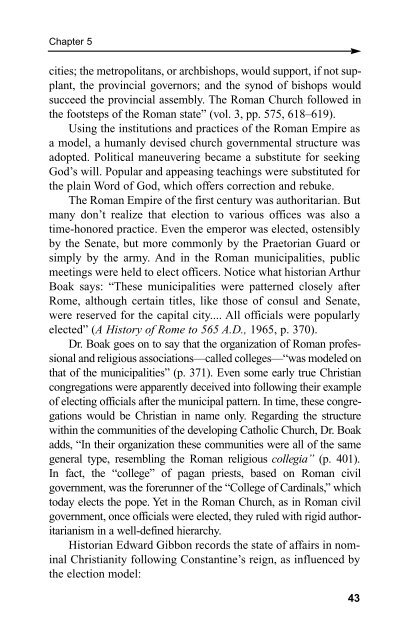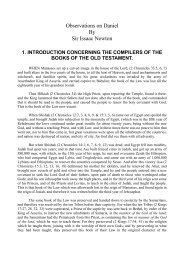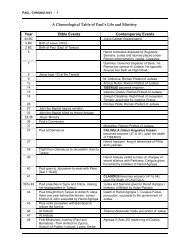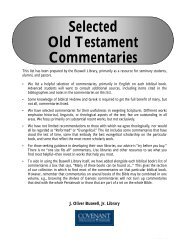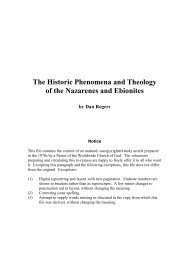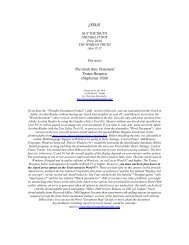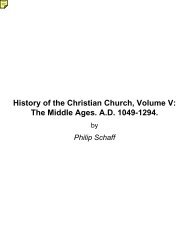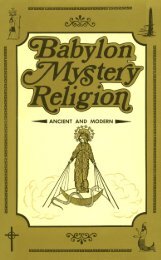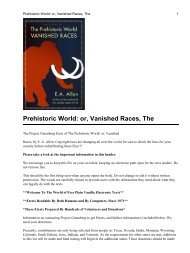Beast of Revelation.pdf - Friends of the Sabbath Australia
Beast of Revelation.pdf - Friends of the Sabbath Australia
Beast of Revelation.pdf - Friends of the Sabbath Australia
You also want an ePaper? Increase the reach of your titles
YUMPU automatically turns print PDFs into web optimized ePapers that Google loves.
Chapter 5<br />
cities; <strong>the</strong> metropolitans, or archbishops, would support, if not supplant,<br />
<strong>the</strong> provincial governors; and <strong>the</strong> synod <strong>of</strong> bishops would<br />
succeed <strong>the</strong> provincial assembly. The Roman Church followed in<br />
<strong>the</strong> footsteps <strong>of</strong> <strong>the</strong> Roman state” (vol. 3, pp. 575, 618–619).<br />
Using <strong>the</strong> institutions and practices <strong>of</strong> <strong>the</strong> Roman Empire as<br />
a model, a humanly devised church governmental structure was<br />
adopted. Political maneuvering became a substitute for seeking<br />
God’s will. Popular and appeasing teachings were substituted for<br />
<strong>the</strong> plain Word <strong>of</strong> God, which <strong>of</strong>fers correction and rebuke.<br />
The Roman Empire <strong>of</strong> <strong>the</strong> first century was authoritarian. But<br />
many don’t realize that election to various <strong>of</strong>fices was also a<br />
time-honored practice. Even <strong>the</strong> emperor was elected, ostensibly<br />
by <strong>the</strong> Senate, but more commonly by <strong>the</strong> Praetorian Guard or<br />
simply by <strong>the</strong> army. And in <strong>the</strong> Roman municipalities, public<br />
meetings were held to elect <strong>of</strong>ficers. Notice what historian Arthur<br />
Boak says: “These municipalities were patterned closely after<br />
Rome, although certain titles, like those <strong>of</strong> consul and Senate,<br />
were reserved for <strong>the</strong> capital city.... All <strong>of</strong>ficials were popularly<br />
elected” (A History <strong>of</strong> Rome to 565 A.D., 1965, p. 370).<br />
Dr. Boak goes on to say that <strong>the</strong> organization <strong>of</strong> Roman pr<strong>of</strong>essional<br />
and religious associations—called colleges—“was modeled on<br />
that <strong>of</strong> <strong>the</strong> municipalities” (p. 371). Even some early true Christian<br />
congregations were apparently deceived into following <strong>the</strong>ir example<br />
<strong>of</strong> electing <strong>of</strong>ficials after <strong>the</strong> municipal pattern. In time, <strong>the</strong>se congregations<br />
would be Christian in name only. Regarding <strong>the</strong> structure<br />
within <strong>the</strong> communities <strong>of</strong> <strong>the</strong> developing Catholic Church, Dr. Boak<br />
adds, “In <strong>the</strong>ir organization <strong>the</strong>se communities were all <strong>of</strong> <strong>the</strong> same<br />
general type, resembling <strong>the</strong> Roman religious collegia” (p. 401).<br />
In fact, <strong>the</strong> “college” <strong>of</strong> pagan priests, based on Roman civil<br />
government, was <strong>the</strong> forerunner <strong>of</strong> <strong>the</strong> “College <strong>of</strong> Cardinals,” which<br />
today elects <strong>the</strong> pope. Yet in <strong>the</strong> Roman Church, as in Roman civil<br />
government, once <strong>of</strong>ficials were elected, <strong>the</strong>y ruled with rigid authoritarianism<br />
in a well-defined hierarchy.<br />
Historian Edward Gibbon records <strong>the</strong> state <strong>of</strong> affairs in nominal<br />
Christianity following Constantine’s reign, as influenced by<br />
<strong>the</strong> election model:<br />
43


